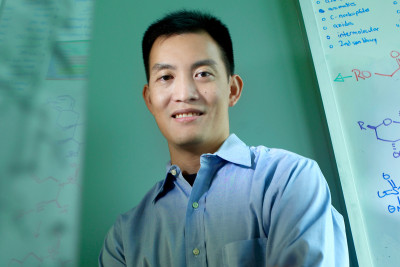
Derek Tan, a chemist and a member of the Sloan Kettering Institute’s Molecular Pharmacology and Chemistry Program, is searching for new chemical molecules that could one day be used as drugs to treat cancer and bacterial infections.
Dr. Tan’s laboratory draws inspiration from compounds found in nature as starting points for this work.
We spoke with Dr. Tan about natural products and the attractive features they offer in the development of new drugs.
What are natural products?
Natural products are molecules that are produced by living organisms. They are often made by bacteria and fungi, but they may also be made by plants and animals.
Natural products have their roots in traditional medicine, such as herbal remedies used in Eastern medicine. They also have a rich history in drug discovery and chemical biology, particularly in the fields of cancer and infectious diseases.
In fact, about 65 percent of anticancer drugs and 75 percent of antibiotics have been derived in some fashion from natural products.
Nevertheless, natural products are still relatively underexploited for drug development. In large part this is because these molecules often have complex chemical structures and are difficult to synthesize in the laboratory, especially in the quantities that would be needed to study them in preclinical animal trials and eventually in patients.
Why do so many of these compounds have anticancer activity?
In some cases, these molecules have general cytotoxic, or cell-killing, properties. This is the case with some of the older natural product drugs, such as paclitaxel, which is derived from the Pacific yew tree, and vincristine, which is derived from the Madagascar periwinkle. They may have evolved in microorganisms or plants as agents of “microbial warfare,” fending off attacks from other organisms.
In other cases, these compounds may target a certain protein structure that is evolutionarily conserved between microorganisms and higher organisms. As a result, even though the compounds did not evolve to target a human cancer pathway, they may do so by acting on a similar protein structure found in humans.
How do you go about looking for products that might be effective against cancer?
There are two different ways in which we can do this. One is a hypothesis-driven approach called rational design and the other is an empirical approach called screening.
With rational design, if you know the structure of the protein whose activity you’re trying to affect, and you understand the biochemistry that the protein carries out in cells, then you can use that structural and mechanistic information to design a molecule that will fit into what is often called the “active site” of the protein. The compound can inhibit or modulate the activity of the protein by binding to that active site, blocking interactions with other molecules or proteins.
On the other hand, there are many cases where we don’t have that structural and mechanistic information, and then we turn to empirical screening. Historically, this has involved testing natural product extracts for various biological activities, such as cytotoxicity.
Today, this is carried out in a more rapid, automated fashion through what is called high-throughput screening. With this method, we can screen many different compounds in many different biological tests, or assays, to see which ones affect individual proteins that we’d like to influence.
In both cases, once we identify compounds that may have a desired effect, we can study them further to improve their biological properties.
Tell us more about the challenges researchers face in developing new drugs against cancer and other diseases.
Right now the pharmaceutical industry is focused on a very narrow range of molecule types in the pursuit of new drugs. There are about 21,000 drugs currently approved by the Food and Drug Administration, but they act on only about 270 protein targets.
Many of the drugs now in the development pipeline address these same targets, partly because of issues related to the difficulty and expense of making and testing new compounds that can address novel drug targets.
On the other hand, it’s been suggested that up to 10 percent of the 20,000 proteins encoded in our genome may make good drug targets, so this means there’s a lot of room for improvement in developing a more diverse range of new drugs.
At Memorial Sloan Kettering, we are in an excellent position to address these challenges. On the biology side, we are studying the molecular causes of cancer, using approaches that include biochemistry and cancer genomics, to identify promising targets for novel anticancer agents
On the chemistry side, we’re trying to develop new classes of molecules that are complementary to these novel biological targets. In my lab, we’re doing this by using insights we’ve gained through the study of natural products to design new inhibitors and new libraries of compounds for screening.
What are the next steps for your laboratory?
On the rational design side, our research program has focused primarily on antibacterial agents thus far. That work resulted in a compound that addresses a novel antibiotic target, and we have shown that it has promising activity in a mouse model of tuberculosis. We hope that one day we may be able to translate this discovery into the clinic.
On the screening side, our work is at an earlier stage as we invest in developing new chemistries to synthesize libraries of compounds related to natural products. We try to identify key motifs in the structures of natural products that we believe are the basis for their biological activities. We’re also addressing a number of fundamental challenges in chemistry to access these molecules efficiently.
We have a number of collaborations both inside and outside Memorial Sloan Kettering to screen the libraries we’ve made against a wide range of molecular targets, including novel anticancer targets as well as antibacterial targets.
As this work moves forward, our goal is to find promising compounds as starting points that will one day enable us to develop new drugs to treat cancer and infectious diseases.


